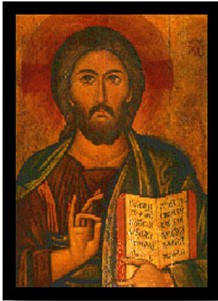The Jesus Prayer

Lord Jesus Christ,
Son of God,
have mercy on me,
a sinner!
The Jesus Prayer is one of the oldest of Christian prayers, dating in its original form to the words the two blind men cried out to Jesus in Matthew 20:31. It was formalized by the fifth century, and is part of our heritage of prayer even to this day. It also serves as perhaps the most succinct Gospel message available. Contained in the Jesus Prayer are core elements of our Christian faith: Jesus is declared by name to be the Christ, the anointed one of God, as well as being the Lord of our lives. He is proclaimed to be the Son of God, and therefore divine. He is acknowledged to be in the position of judgment and mercy, and we confess to be sinners who are always in need of his saving, empowering, and divinizing grace.
The Jesus Prayer is also a form of the constant prayer that Saint Paul speaks of in his First Letter to the Thessalonians (5:17), where prayer is kept on the lips and in the hearts of believers at all times. By repeating the Jesus Prayer several times each day, for several minutes at a time, this beautiful prayer ultimately sinks into our consciousness. Eventually, we no longer pray the prayer, but the prayer begins to pray us. At this point, the real blessings of the Jesus Prayer start to become evident in our lived experience of faith, along with the increased consolation of the Holy Spirit. An inward stillness gradually springs up within us when we “become this prayer.” And thus we grow closer to Jesus, becoming one with him in faith, hope, and love.
When a state of contemplation is reached through the Jesus Prayer, Jesus is literally always on our mind. We begin to see him more clearly in the sacraments, in other people, in the circumstances of daily life, and even in ourselves. Through the Jesus Prayer, Jesus is also literally in our hearts. We begin to feel that, as forgiven sinners, we are able to lovingly extend that same mercy to other sinners as well. Finally, through the Jesus Prayer, Jesus is also in our hands. Whatsoever we do to the least of our brothers and our sisters, we knowingly do unto Christ himself. Thus, we can begin to live more consciously and conscientiously according to the Beatitudes, and continue practicing even more fervently the spiritual and corporal works of mercy as privileges to be embraced, rather than just duties to be fulfilled. The Jesus Prayer brings all these blessings together as one.
In order to reap all the spiritual benefits of the Jesus Prayer, many people use a prayer rope as an aid to developing this unique prayer form in their spiritual lives. While the use of a prayer rope is not necessary, it is a beneficial tool. If you are interested in obtaining a prayer rope, just do an internet search for “prayer ropes” or the “Jesus Prayer.” You can also just use your regular Rosary or Chaplet to help you enter into the contemplative state that the Jesus Prayer offers to all who take the time to make the Jesus Prayer the “prayer of the heart” that it is truly meant to be. The rest of the spiritual journey is really between you and Jesus, for he will be your companion and guide along the way. Jesus loves us enough to accept us just the way we are, and then he loves us even more, by giving us the grace to become all that we were destined to be as sons and daughters of God.

The Jesus Prayer provides us with another helpful way to make the contemplative journey into the heart of Christ. Based on the biblical prayer of the humble man in the back of the Temple, and the many calls for Jesus’ mercy, this traditional hesychastic prayer of the Christian east has even surfaced in the new Rite of Penance. Let’s start with the words: (1) Lord Jesus Christ, (2) Son of God, (3) have mercy on me, (4) a sinner. Now let’s add the hesychastic element to it: (1) Breathe in, (2) hold your breath, (3) exhale, (4) and stay empty as you recite the four parts of the Jesus Prayer.
Eastern Christian hesychasm moves beyond meditation to contemplation as an altered state of consciousness. Hesychasm comes from Eastern Christian spirituality, both Byzantine Catholic and Orthodox Christian. Hesychasm goes deeper than thoughts and feelings, to interior silence that dwells in the heart of Christ. Hesychasm opens our hearts to the Heart of Christ in a state of simply being, instead of just doing. The Rosary is a meditative form of prayer: left brain = chanting Ave’s / right brain = visualizing mysteries. The Jesus Prayer is so simple, even a man can do it. It requires no multi-tasking at all. It is one simple prayer. Keep on repeating it to the point that you are no longer praying it – but it starts praying you! The frequencies of the following brain waves help us to understand the journey from vocal prayer, through meditative prayer, to contemplative prayer.
Consciousness: Active-Beta = 40-15c || Relaxed-Alpha = 14-9c || Meditative-Theta = 8-5c || Sleep-Delta 4-1c. Contemplation is an infused gift of the Spirit that we cannot evoke, but we can prepare ourselves to receive. Contemplation occurs on the very penumbra of meditation and sleep (like some congregants during sermons): 4.5c. Contemplation is like a form of open-heart surgery, where Jesus brings supernatural healing to broken hearts. Just before we lapse into utter unconsciousness, we can have a semi-conscious twilight-experience of ecstasy. Similar to being slain in the Spirit, we are in a divinizing zone that the apostles experienced at the Transfiguration of Christ.
The Jesus Prayer can help us focus and drill deeper into the contemplative heart of Eucharistic Adoration. It can calm us down whenever we are upset, or help us fall asleep when we just cannot seem to let go. There are also prayer ropes to help: 33 knots, a cross, and a tassel to wipe away tears of compunction. Memorize this prayer. Repeat it until it is embedded into your consciousness like a subliminal message. Abandon yourself to what Eastern Christian mystics call “the prayer of the heart” to reach a state of God-consciousness.
The Hebrews located the heart in the pit of our stomachs, like the oriental “hara,” where the mystery of life also begins. The Jesus Prayer provides us with another well-worn spiritual path into the Eucharistic Heart of Christ. So, recite liturgical prayers. And meditate with creative visualizations. Then contemplate by resting in God. Finally, pray that Jesus will show you how to be as merciful to others as he has already been merciful to you. You can experience yet another way of entering into the mystery of the Jesus Prayer by prayerfully chanting it.

For Further Prayerful Reflection and Study about the Jesus Prayer
The Jesus Prayer by Kallistos Ware | The Jesus Prayer: The Ancient Desert Prayer that Tunes the Heart to God by Frederica Mathewes-Green
On the Prayer of Jesus: The Classic Guide to the Practice of Unceasing Prayer as found in The Way of a Pilgrim by Ignatius Brianchaninov
Searching for and Maintaining Peace: A Small Treatise on Peace of Heart by Jacques Philippe
Inward Stillness by George Maloney | Navigating the Interior Life by Dan Burke | The Fulfillment of All Desire by Ralph Martin
Hidden Mountain, Secret Garden by Anthony Lilles | Holiness for Everyone by Eric Sammons | Into His Likeness by Edward Sri
Plan of Life by Roger Landry | Seeking First the Kingdom by John Bartunek | Under the Influence of Jesus by Joe Paprocki
Life of Jesus by Francisco Fernandez-Carvajal | Jesus: The Story You Thought You Knew by Keith Strom

